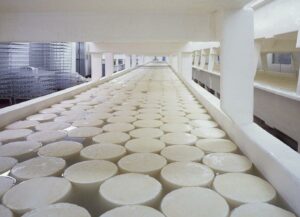Fernando Diaz
Rumen buffers such as sodium bicarbonate are commonly included in lactating cow diets to stabilize rumen pH. Recently, calcareous marine algae have been used for buffering dairy diets. Lithothamnion calcareum is a red alga of the Corallinacea family whose main feature is the formation of calcium and magnesium carbonate precipitates in its cell walls. Calcium and magnesium are the major minerals of this alga, and other trace elements include iron, manganese, boron, nickel, copper, zinc, molybdenum, selenium, and strontium.
A recent study examined the effects of feeding a calcareous marine algae buffer in comparison with sodium bicarbonate in milk performance of mid-lactation dairy cows. The researchers (Neville et al., 2019), from University College Dublin, fed a basal diet including no dietary buffer, and the same diet including 0.35% calcareous marine algae in a DM matter basis (DM; 80 g/cow) or 0.7% DM sodium bicarbonate (160 g/cow). The diets contained 46% forage (22% corn silage; 22% grass silage; and 1.7% wheat straw), and protein and starch concentrations were 16.5 and 25-25.8% DM, respectively.
Additionally, in another experiment conducted in 4 four cannulated cows, the researchers evaluated buffering capacity of the rumen buffers. Rumen pH was measured using internal pH probes linked to a data logger.
The findings were published in the Journal of Dairy Science and these were the main results:
- Dry matter intake was slightly higher in cows fed the bicarbonate diet (22.1 kg/day) than cows receiving the calcareous marine algae (21.7 kg/day) or no dietary buffer (20.7 kg/day).
- No differences were observed among diet for milk yield (32.5 kg/day), fat-corrected-milk (31.4 kg/day), and energy-corrected milk yield (34.5 kg/day).
- Cows fed the diets with buffers produced more milk fat (1.28 kg/day) than cows fed the basal diet (1.25 kg/day). Milk protein yield was greater in cows supplemented the alga buffer (1.07 kg/day) than in cows supplemented with bicarbonate or unsupplemented cows (1.03 kg/day).
- Compared with cows fed no buffer (3.68%), milk fat content increased significantly in cows fed the buffer diets (3.87%). Surprisingly, milk protein content was lower in cows fed bicarbonate (3.18%) than in cows fed the alga buffer or no buffer (3.24%).
- Both buffer diets had a greater average daily rumen pH (6.19) compared with the basal diet (5.92). Similarly, cows fed no rumen buffers showed a greater number of hours below pH 5.5 (6.1 h) compared to cows fed bicarbonate (3.17 h) or the alga buffer (0.77 h).
In conclusion, according to these results, calcareous marine algae (Lithothamnion calcareum) product is an effective rumen buffer. At a level of 80 g/cow per day, this buffer had a greater effect on rumen pH and milk composition than sodium bicarbonate at a level of 160 g/cow per day. More research is warranted to evaluated different buffer inclusion rates and income over feed cost.
Reference
W. Neville, A. G. Fahey, V. P. Gath, B. P. Molloy, S. J. Taylor, and F. J. Mulligan. 2019. The effect of calcareous marine algae, with or without marine magnesium oxide, and sodium bicarbonate on rumen pH and milk production in mid-lactation dairy cows. J. Dairy Sci. 102:8027–8039.
© 2019 Dairy Knowledge Center, LLC. All Rights Reserved.







